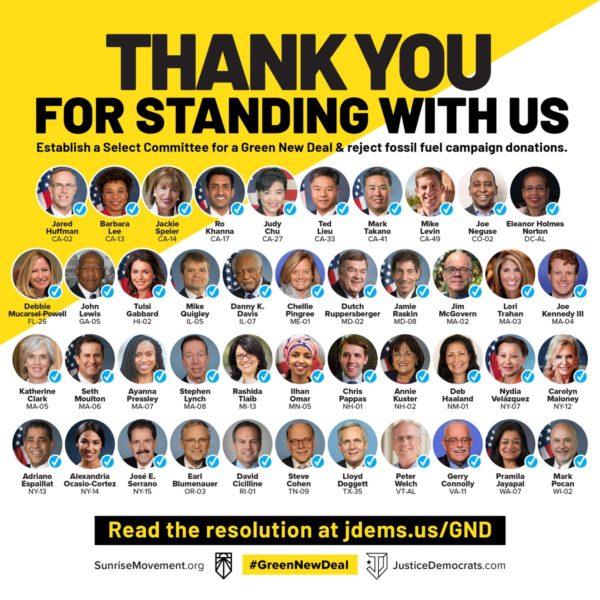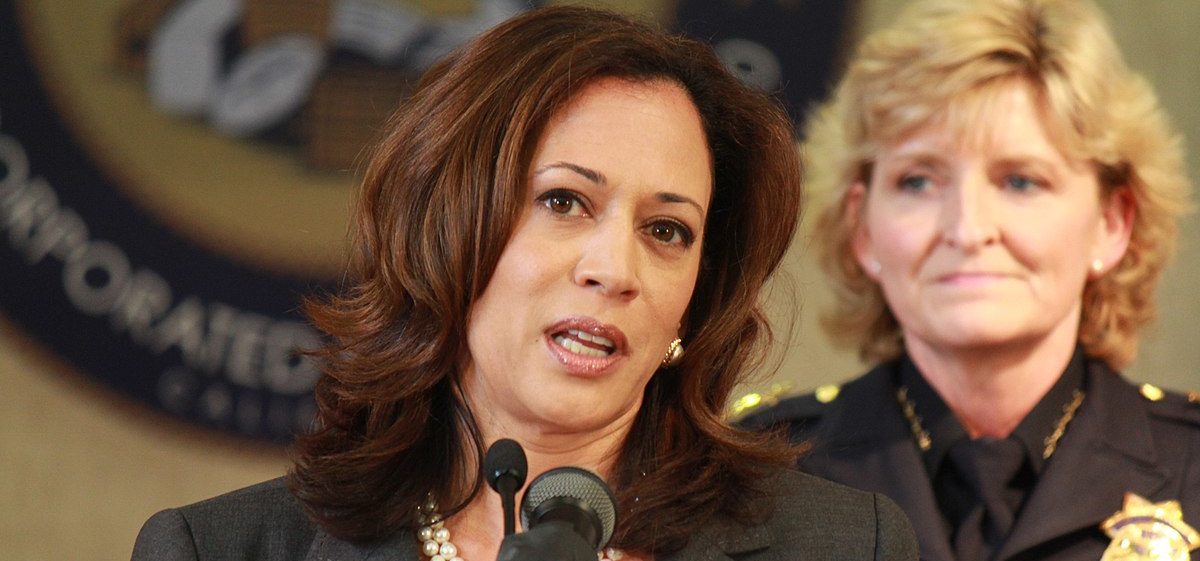It’s been a big 24 hours for the Green New Deal. Yesterday afternoon U.S. Senator and presidential candidate Kamala Harris (D-California) announced her support for the federal mobilization to address climate change and create jobs. Since this is 2019, the news came as a tweet.
I support a Green New Deal. Climate change is an existential threat to all of us, and we have got to deal with the reality of it.
— Kamala Harris (@KamalaHarris) January 29, 2019
And not to be outdone, this morning billionaire, philanthropist and businessman Michael Bloomberg announced that he would give details of his own plan for a Green New Deal. Which is interesting, because he hasn’t yet announced that he is running for president (or ruled it out, either).
Today I announced I'll outline a plan for a Green New Deal, accelerating US transition to 100% clean energy. The 1st pillar will be investing in people & communities that powered our economy for decades. The econ benefits of a Green New Deal must reach every corner of the country pic.twitter.com/Fvjdondyu4
— Mike Bloomberg (@MikeBloomberg) January 29, 2019
Harris wasn’t the first presidential candidate to announce her allegiance to the idea, as Senator Kirsten Gillibrand (D-New York) voiced support last week. As has Elizabeth Warren, who is still in the exploratory committee stage and hasn’t formally launched a campaign.
The slogan is also being picked up at the state level, with New York Governor Andrew Cuomo (D) labelling his administration’s legislative priorities including a more ambitious renewable energy mandate as a Green New Deal for his state.
But what is the Green New Deal, and why are public figures with political ambitions getting in line to back it?
Green New Deal Basics
The concept of a Green New Deal has been around for decades, and was part of the platform of Green Party candidates in several presidential elections before breaking into the mainstream courtesy of the Sunrise Movement and freshman Member of Congress/social media star Alexandria Ocasio Cortez (AOC, D-New York).
The idea is based on former President Franklin Delano Roosevelt’s New Deal programs implemented during the Great Depression, which included public works programs (the WPA), a social safety net (Social Security), rural electrification (the Tennessee Valley Authority), expanded rights for workers and financial reform.
The Green New Deal applies this framework of public works, societal reforms and social programs molded to the task of addressing climate change, and as a central component includes a move to clean energy; in the Sunrise Movement/AOC version it calls for a move to 100% renewable energy by 2030.
A few other things you should know about the Green New Deal:
It’s popular
A December poll by the Yale Program on Climate Change Communication found that 81% of voters questioned supported the concept of a Green New Deal when it was explained to them, with majorities across the political spectrum – although more support from left-leaning voters.
 This support has made its way into the halls of Congress. 42 other U.S. Representatives (10% of the seats in the U.S. House) joined AOC in supporting the call for a select committee for a Green New Deal, before Democrat leaders put the brakes on an instead created a much weaker committee on climate change.
This support has made its way into the halls of Congress. 42 other U.S. Representatives (10% of the seats in the U.S. House) joined AOC in supporting the call for a select committee for a Green New Deal, before Democrat leaders put the brakes on an instead created a much weaker committee on climate change.
The portion of support by conservative voters for the idea is not shared by conservative groups, who are largely aghast at the implications of Social Democratic programs – that is, those who are not totally against the idea because they are still in the climate denial camp.
It’s subject to interpretation
While 81% of voters supported polled by Yale supported the concept of a Green New Deal, 82% didn’t know that there was a policy being proposed to this effect, expressing that they had heard “nothing at all” about it.
 And while this number may have shrunk somewhat since that poll, the number of Americans who do not understand this policy may be useful for those who want to craft their own version of the Green New Deal. While Cuomo’s Green New Deal contains more ambitious renewable energy deployment and job creation, it stops short of some of the more radical aspects of the program as outlined by AOC and the Sunrise Movement.
And while this number may have shrunk somewhat since that poll, the number of Americans who do not understand this policy may be useful for those who want to craft their own version of the Green New Deal. While Cuomo’s Green New Deal contains more ambitious renewable energy deployment and job creation, it stops short of some of the more radical aspects of the program as outlined by AOC and the Sunrise Movement.
This is why activists have expressed skepticism at Mike Bloomberg’s “Green New Deal” announcement, as Bloomberg has supported strong moves on decarbonization, but has had mixed rhetoric on taxes, and might have different ideas about the jobs guarantee and other redistributive aspects of the program.
It’s about jobs and social justice as much as the climate
While 100% renewable energy by 2030 may be a top-line demand of the Green New Deal, the legislation is much, much more than that. The Sunrise Movement insists that anything called the Green New Deal must include net zero greenhouse gas emissions by 2030, a federal job guarantee for all Americans, clean air and water, and “a just transition for all communities and workers”.
The version of proposed legislation introduced by AOC included a suggestion of a minimum basic income as well, although this has not been stressed as strongly as other portions of the plan. (For more background on the Green New Deal, read this write-up by Vox’ David Roberts).
It comes out of political organizing
While AOC has carried the torch of the Green New Deal into the limelight, the core members of Sunrise Movement had been organizing for years to get to the protest at Nancy Pelosi’s office that catapulted this idea onto TV and internet screens across the nation.
As such, that this idea is coming up in presidential debates is not accidental. After the movement saw a clear defeat with Pelosi’s creation of a weak Congressional committee, Sunrise Movement turned its attention to the presidential campaign.
Sunrise Movement is already planning to gather “thousands” to the first primary debate, and it is notable that Senator Harris announced her support for a Green New Deal at a campaign rally after activists dropped a banner over the 20,000-person strong crowd.
As the Atlantic has observed, there are many barriers to this proposal becoming federal legislation. However that may miss the point, as the Green New Deal is already inspiring action at the state level, and is having a strong effect on the national political discourse.
Whether or not a Green New Deal bill is passed through Congress, and whatever politicians do or don’t support this call, or however they interpret or modify it to suit their ends, the concept isn’t going away. Not as long as Sunrise Movement has an army of young people across the nation, and a powerful idea.
Help us understand you better! Please take a moment to take our audience survey.
This content is protected by copyright and may not be reused. If you want to cooperate with us and would like to reuse some of our content, please contact: editors@pv-magazine.com.









As a lifelong environmentalist and hard core liberal, I am exceedingly dismayed about the emphasis upon the word “renewable” to refer to the energy resources of the 18th century and earlier.
“renewable” is an irrelevant virtue. The problem with coal and carbon tetrahydride, CH₄. is not the fact that it would take 60 million years to renew them, but that their emissions are poisonous and biosphere-warning contaminants to the atmosphere.
As far as solar power being “renewable”, it may be observed that the Earth’s store of thorium, which has the equivalent of ten million kilowatt.hours of energy per kilogram, decays so slowly that more than half of it will remain when the sun uses up all its hydrogen for fusion, and goes Red Giant.
But it is silly to predict what human civilization will care about , even one thousand years from now, if it survives.
A Green New Deal is certainly needed, but if its proponents do not realise that the alternative to dirty coal and gas is nuclear fission, despite the huge propaganda against it, they Will Not achieve their goals.
As for “employment”, read Bertrand Russell’s essay “In Praise of Idleness”. There is a certain amount of work needed to produce goods and services, but there is a huge amount of “employment” that is amazingly wasteful. One of the things it wastes is leisure, which in the old days of peasants and slaves was the privilege of the aristocratic classes, including Russell’s ancestors. But he insists that it should be more fairly distributed.
“Employment” is necessarily invidious. It involve somebody else telling you what work to do.
“Work” is something that you yourself, ideally, would decide was necessary.
It is interesting that you mention nuclear fission, but then only focus on thorium. To my knowledge there are no commercially available thorium reactors on the market, so there is no reason to include them in a plan to decarbonize electricity in the next 12 years.
Additionally, nuclear power plants using our current uranium-based fission technology currently take around a decade to build, and also cost around 3-4x as much per unit of energy delivered as solar and wind. Therefore building new nuclear reactors is simply not a practical strategy for decarbonization on the timeframe that the IPCC says is necessary (by 2030).
It is remarkable to me how much time nuclear proponents spend trying to spread their propaganda. But as pv magazine staff do not have endless time to spend repeatedly debunking the same mythologies and false claims, yours is the last comment on this subject that we will publish.
If Kamala Harris can’t even notice a homeless man passed out on a bench from a giant window,, she sure can’t notice anything else important in this country. Her myopic narcissitic view of life is typical of so many politicians. They don’t see us, they see themselves and how they can use us. No thanks. Next. Not Harris. She’s the same old, same old. Boring. Puppet. Nothing new. Nothing special.